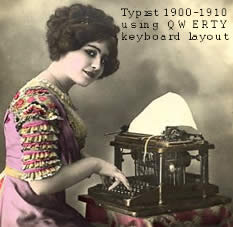Qwerty and Dvorak keyboards compared:

Qwerty keyboard was designed for the machine, to improve the performance of the machine not the typist.
Dvorak keyboard was designed for the typist, to make typing more efficient, more comfortable, faster.
Qwerty - the US standard keyboard layout
Originally keys were laid out in alphabetical order which caused frequent jams of moving parts. Sholes rearranged the keys so that most frequently typed letters were spread apart to minimize the jamming. He obtained a patent for this keyboard layout which became known as QWERTY and became US standard keyboard layout.
With the invention of electrical typewriter in 1930's which used a ball to type letters rather then moving arms, an opportunity arose to redesign keyboard layout to improve typing efficiency. From numerous keyboard layouts proposed and tested, Dvorak keyboard became the alternate American standard.
ANSI Dvorak keyboard layout - commonly known as the Dvorak keyboard or the Simplified Dvorak
Dvorak keyboard was designated an alternate standard keyboard layout by the American National Standards Institute (ANSI) in 1982.
In 1984 the Dvorak keyboard had an estimated 100,000 users. Today Dvorak keyboard layout software is available in Windows, Mac, Linux operating systems. It has also been called the Simplified Keyboard or American Simplified Keyboard, but is commonly known as the Dvorak keyboard. It was designed by Drs. August Dvorak and William Dealey in the 1920s and 1930s. The two studied letter frequency and the physiology of the hand and created the layout to adhere to these principles:- It is easier to type letters alternating between hands.
- For maximum speed and efficiency, the most common letters and digraphs should be the easiest to type. This means that they should be on the home row, which is where the fingers rest.
- Likewise, the least common letters should be on the bottom row, which is the hardest row to reach.
- The right hand should do more of the typing, because most people are right-handed.
- It is more difficult to type digraphs with adjacent fingers than non-adjacent fingers.
- Stroking should generally move from the edges of the board to the center (as an example, rap your fingers on a table and see which is easier: going from pinkie finger to index or index to pinkie). This motion on a keyboard is called inboard stroke flow.
The layout was completed in 1932 and was granted U.S. Patent No. 2,040,248.
Pros to use Dvorak keyboard:
Lots of sites go to great details Here is just summary- increased comfort - (the top reason for typist suffering with RSI - repetitive strain injuries)
- increased efficiency
- better accuracy
- faster
- shorter learning curve (estimated 50% shorter then Qwerty)
Cons to use Dvorak keyboard
Dvorak keyboards are expensive - You don't need to rush out and buy Dvorak keyboard. Today's computers come with free Dvorak software installed and all you need to do is to switch in Control Panel to Dvorak keyboard.
I already know Qwerty - if you do not have a need to retrain that's fine, but does the new generation have to use obsolete typing method because once up on a time there was a typewriter with moving arms in it?